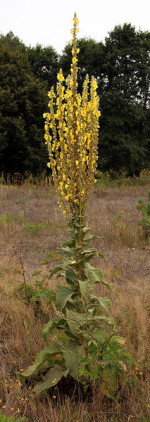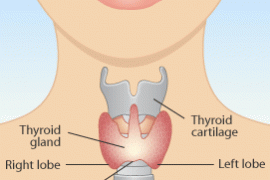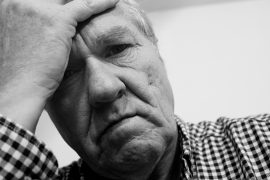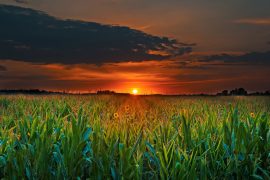It was Emerson who said “A weed is an herb whose virtues have not yet been discovered.” Many people may look at mullein as nuisance weed, but it has a long history of medicinal and practical use. While many find mullein a problem plant, I just see the benefits. It is one of my favorite herbs. It is the one I use if I have any lung congestion and it works every time.
The common mullein (Verbascum thapsus L.), is in the snapdragon family. The plant is rich in calcium phosphate, iron, magnesium, potassium and sulfur. It is a practical and medicinal plant readily found along roadsides, meadows and pastures. This plant has been used to treat pulmonary problems, inflammatory diseases, asthma, spasmodic coughs, diarrhea and migraine headaches. Although it has been used medicinally since ancient times, the popularity of common mullein has been increasing commercially for the past few years. Today, the dried leaves and flowers, capsules, alcohol extracts and the flower oil of this plant can easily be found in health stores in the United States. The use of common mullein extracts in folk medicine begun recently to be supported by an increasing number of research studies.
Mullein is a biennial plant. During its first year of growth, the large leaves form a low-lying rosette. In the spring of the second year, the plant develops a tall stem that can grow to more than four feet in height. The top portion of the stem develops yellow flowers that have a faint, honey-like odor. Common Mullein flowers are yellow with five petals. Flowers are about an inch wide. They bloom a few at a time from June to September. Mullein produces a huge numbers of seeds. One mullein plant may make over 100,000 seeds in a year. Hummingbirds sometimes use the soft leaves to line their nests. Many insects come to mullein flowers for nectar. Bumble bees, honey bees, and hover flies help pollinate these plants.
Non Medicinal Uses
The leaves when dried are excellent tinder for starting a campfire.
The leaves cut into long strips and dried were used as oil lamp wicks.
Throughout history the dried flower stalks were used as torches.
Medicinal Properties
Demulcent, Emollient, Astringent, Anodyne(Pectoral)
This herb is used for coughs, bronchitis, whooping cough, asthma, hay fever and other respiratory conditions. It is also used for colic, constipation and urinary tract infections.
The oil of mullein (flowers) is used for earaches.
Click here to view mullein recipes for earaches.
Studies
The flower infusion of mullein shows antiviral activity against, several influenza A strains, influenza B strain as well as Herpes simplex virus. (1)
A study done with one hundred children at pediatric ambulatory centers, ages 6-18 with acute otitis media (AOM) yielded some impressive results. The children were divided into two groups. One group received naturopathic ear drops with Allium sativa, Verbascum Thapsus (mullein), Calendula flores, and Hypericum perforatum in olive oil. The other a pharmaceutical containing ametocaine and phenazone in glycerin to determine the management of ear pain associated with AOM. The conclusion was that Otikon, an ear drop formulation of naturopathic origin, is as effective as Anesthetic ear drops and was proven appropriate for the management of AOM-associated ear pain. (2)
In 2003 a total of 171 children who were aged 5 to 18 years and had otalgia and clinical findings associated with middle-ear infection were studied. The children were randomly assigned to receive treatment with Naturopathic Herbal Extract Ear Drops (NHED) or anesthetic ear drops, with or without amoxicillin. Patients who were given ear drops alone had a better response than patients who were given ear drops together with amoxicillin. Results were better in the NHED group than in the controls. (3)
References:
(1) http://www.ncbi.nlm.nih.gov/pubmed/1666504
(2) http://www.ncbi.nlm.nih.gov/pubmed/11434846
(3) http://www.ncbi.nlm.nih.gov/pubmed/12728112
From The Shepherd’s Purse by Max G. Barlow
Herbal Medicine from the Heart of the Earth by Sharol Tilgner ND
The Herbal Medicine-Maker’s Handbook by James Green
The New Age Herbalist by Richard Mabey








